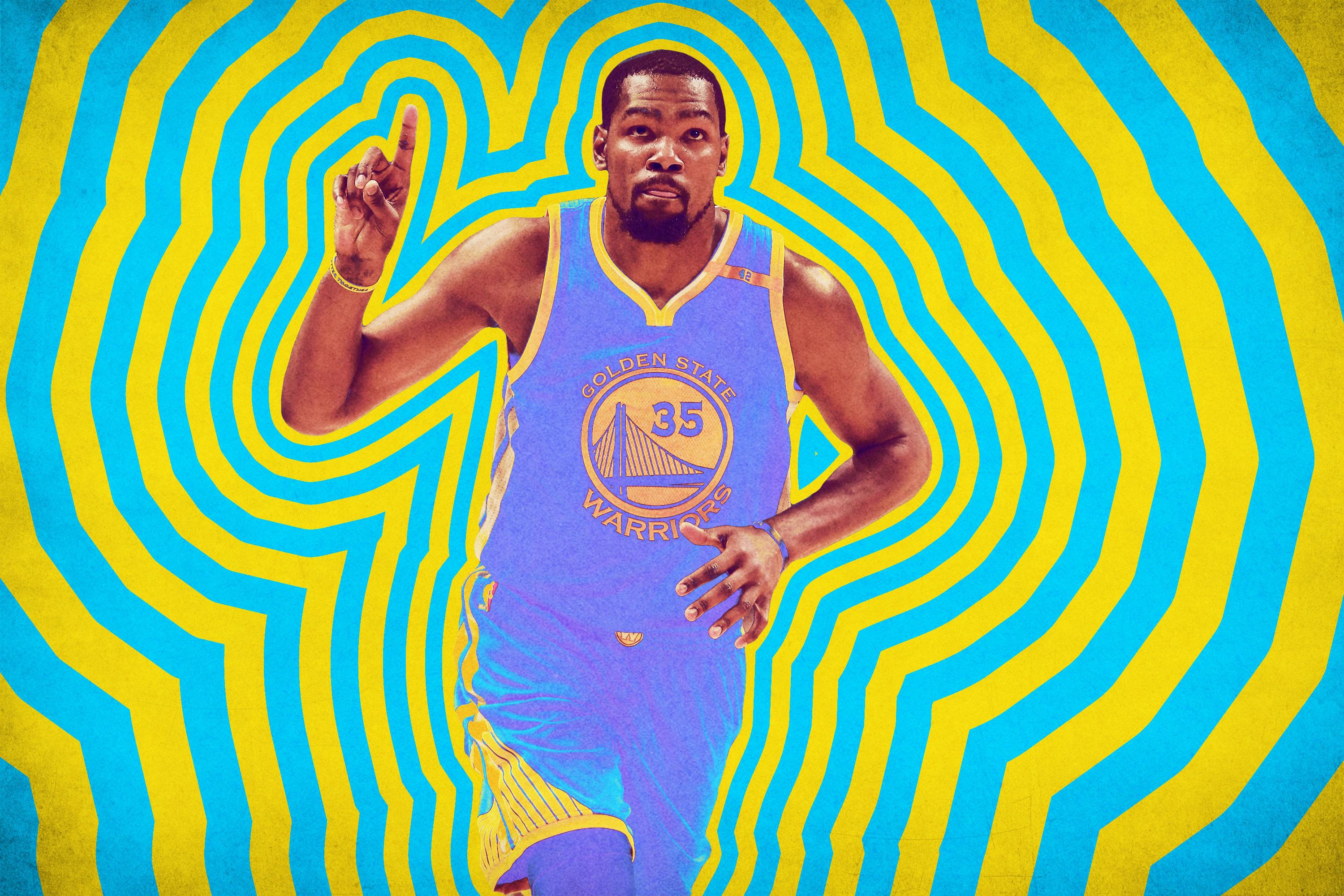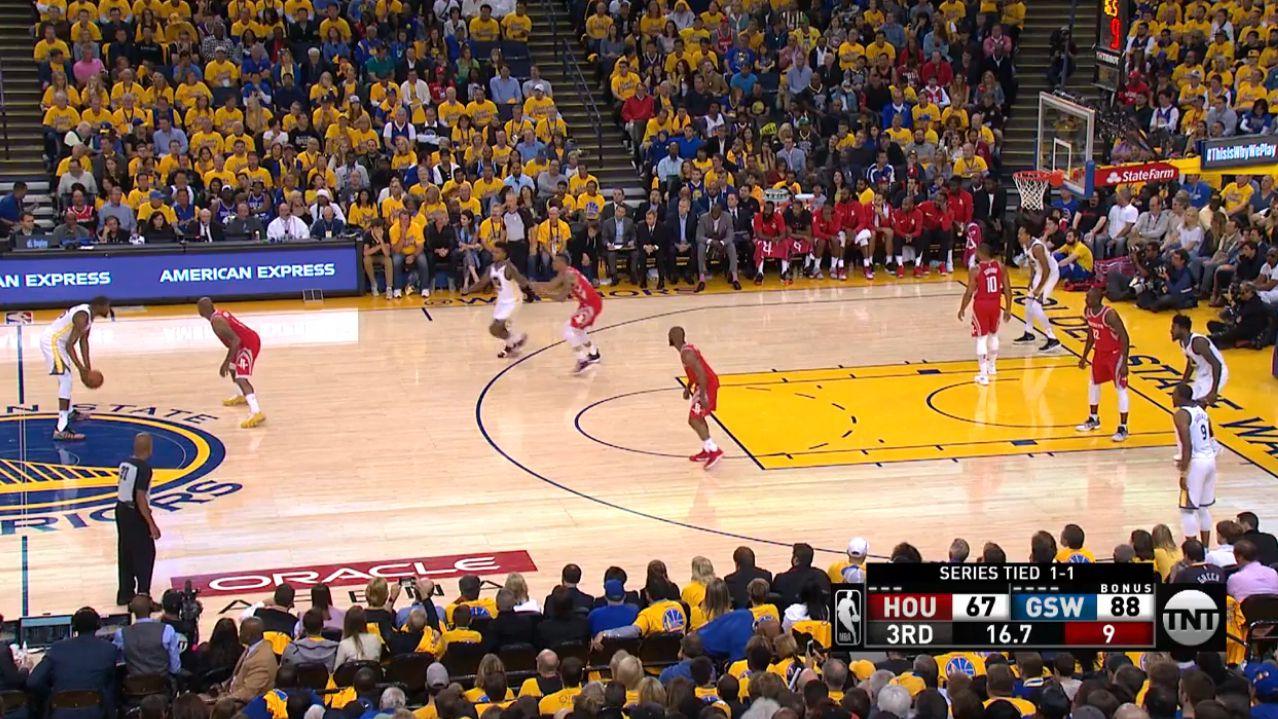
These days, it’s the mundanities of the Warriors offense that snap everything into focus, the lineups and formations that are easily taken for granted until you remember that no other team in the league is even remotely capable of replicating them.
Golden State stretches and compresses space like it were a lump of dough yielding to a cook’s touch. When Kevin Durant initiates a play just one foot past the half-court line, defenses are pulled uncomfortably beyond areas of coverage they’re accustomed to occupying. Maybe in the next 15 years, there will be an infestation of 3-point-shooting giants comfortable serving as the ball handler in a pick-and-roll 46 feet away from the basket, and defending that far out will be a fundamental reality. But as progressive as the NBA would like to think itself to be in 2018, it isn’t there yet. This is still some sort of alien hieroglyph for the defense to decipher:

In space, no one can hear you scream, and no one can defend Durant. During one of the Warriors’ final possessions of a demoralizing third-quarter beatdown in Sunday’s Game 3 (the beginnings of which are seen in the image above), Nick Young forces a switch with Durant’s defender, P.J. Tucker, leaving KD on a minus defender in Gerald Green. He drains some clock, then darts a pass to Andre Iguodala on the right wing for an open 3. Iguodala uses a shot fake to get Luc Mbah a Moute to commit, and then delivers a sharp two-handed bounce pass to Jordan Bell, who proceeds to travel.
Iguodala looks at Durant and points at himself to accept blame. The TNT camera doesn’t capture the entire exchange, but Chris Webber takes the time to paint the scene with a little verbal marionette theater: “How about Durant, upset with Iguodala, saying ‘You shoot the ball! I got it to you first!’ and Iguodala’s like, ‘No, we pass the ball on this team.’”
There was a levity in Webber’s voice that suggested no malice in his portrayal of the situation. But the way he framed their communication pointed to the chasm often placed between the Durant-era Warriors and the two seasons prior. It’s about that time of year when retired NBA players try to chip away at the Warriors’ veneer; over the weekend, Metta World Peace lauded Golden State’s reign with one notable exception. “I don’t see Kevin Durant as being a part of that dynasty,” he said. “I say Kevin has to win this year or next year and then another one. If they win three in a row, that’d be amazing. Two dynasties, just mark them down.”
We’re closing in on two years since Durant made the decision that led to the “Hamptons Five” moniker being foisted upon us, and one year since Durant was the best player in the Finals on arguably the greatest team of all time. For as much as Durant has sublimated himself within the Golden State framework, it’s become clear that he’ll never be an extension of the Warriors’ narrative that began four years ago. He is, as World Peace suggests, the line of demarcation between a time when the Warriors were “bad for basketball” for championing a radical perimeter-oriented game and the present, when they’ve become a villain on par with any in the Marvel Cinematic Universe for “ruining the sport” with an incomparable wealth of top-level talent. On a tier of their own, the Warriors have eliminated the stakes. Durant is the eraser.
But from our vantage, the second-best player on earth (who often flirts with being first) remains an outsider, stuck between the two worlds he wants to inhabit. It’s not just that Durant’s isolations often appear at odds with the kind of tricky, off-ball rapport the Warriors have spent years refining in each other’s company. (Durant has had 79 isolation possessions throughout the playoffs; Steph Curry is second on the team with 14.) It’s the distance he’s put between himself and the expectations that a phenomenally talented professional athlete at the apex of his career is seemingly consigned to live up to. He wants to be the league’s torch-bearer once LeBron James makes his eventual descent from the summit. He also just wants to be one of the guys: a cog in an immaculate machine but not the conductor. Perhaps the role he has in these Western Conference finals is the one he had in mind all along: KD is averaging 33.3 points on 53-43-100 shooting splits in the series, easily the best player on the floor whenever he’s in the game, yet, somehow is often relegated to being the thankless hero.
Maybe it’s because he’s chameleonic. Game 2 aside, Durant’s been a reliably impactful defender in the endless sliding-doors game of switching this series. After hoisting 49 shots on 137 touches and logging only one assist in his first two games, Durant had six assists in Game 3, including fueling two consecutive baskets in Curry’s unconscious third quarter. He also, you know, put up 25 points and six rebounds, and was a team-high plus-27 for the game. He didn’t take questions at the podium. In fact, Steve Kerr answered 16 questions in the Game 3 press conference after the team’s 41-point win, and Durant’s name was not uttered once by the media or by Kerr.
Of course, this isn’t a woe-is-me situation. Both Durant and the Warriors are flourishing in their situation. But it’s worth considering how the rhythms of our collective athlete appreciation have been disrupted by Durant’s selflessness. (It me, Blog Boy.) If there is a comparable assemblage of talent in the past, it’s the Big Three–era Miami Heat, but even then, time shaped a clear hierarchy for that team. The alpha dynamic was sorted out by the end of their first season together: It was clearly a team built around LeBron James. That’s what makes the Warriors’ reality unprecedented: The team isn’t built around its best player. Its best player is an accessory. There is no way to reconcile that fact with any other team, or any other player at any other point in NBA history.
Warriors fans are more than OK with all the wins they’ve amassed with Durant in the fold, but the shift in narrative is at least partially a result of the single-file alignment of the fan base behind Steph. He is the team’s most important player, and the last survivor of the Don Nelson years. He is a prancing, shimmying, sharpshooting reflection of how the past and future converge. There are still some remnants of the underdog mentality in the Bay Area crowd, and they get to relish in it whenever Curry—the small, frail superstar that could—lights it up.
It’s audible. Steph’s perfect 18-point third quarter in Game 3 on Sunday was as riveting a live performance as it was a document of recent nostalgia. It stirred a borderline delirious frenzy among the fans at Oracle, all of it palpable from wherever you were watching the game. Curry was once again ecstatic, and for at least a moment, the joy of witnessing his particular brand of greatness overrode everything. It doesn’t matter that he’s a two-time MVP; his success is a story of continuously bucking improbability, while Durant’s success seems foreordained because of his skill and stature. Every time Curry puts on a dizzying performance, he brings 2015 back to life. Nostalgia is a powerful weapon; Durant has so many tools tucked into that 6-foot-whatever frame, but he doesn’t have that.
And maybe he doesn’t want it. We’ve seen plenty of all-time talents slip through the cracks of time in the game’s history, but it’s always a matter of external circumstance. Durant will likely go down in history as a player underappreciated in his era, almost by his own will. In circumventing the star-athlete archetype and all its pressure, he’s given himself the space to disappear, even as he’s putting up numbers that would inspire awe in any other context. Durant and the Warriors may be a historically unconventional pairing, but if Golden State wins its third championship in four years and Durant racks up his second straight Finals MVP award, there’s no amount of context that could strip either of their distinctions.


